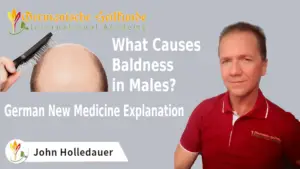
Many are familiar with it, and many suffer from it, the fever blister. One would like us to believe that the cause would be a virus, specifically the herpes virus. But anyone familiar with Dr. Hamer’s legacy knows there are no viruses.
So, what is the true cause, according to German New Medicine?
This short video will give you the answer.
To pinpoint the cause of a symptom, we must first determine the tissue that has reacted. If we know which tissue is affected, we know which conflict to look for.
In the case of herpes, the outer skin has reacted – that is, squamous epithelium, the red group.
The outer skin always has a separation conflict as its cause. The localization of the symptom herpes blister says that one has associated this separation conflict at the lip.
Now there are two ways of experiencing the separation conflict. Either one wanted to be separated conflictively, for example, when one is disgusted by a kiss, or one did not want to be separated conflictively, for example, the farewell kiss.
In the active phase, the squamous epithelium ulcerates, and the skin is sensory deaf. The active phase is usually not noticeable, but the healing phase is painful, with inflammation and swelling.
We have a high sensitivity at the lips and can register the slightest touch. There are a lot of nerves in the lips, which is why the healing phase is often very painful.
The healing phase of the outer skin proceeds without a fever. If a fever is also present, then an additional SBS must be in solution.
In the epi-crisis we have the absence, (this is a brief state of unresponsiveness), which is usually not noticed, and at the end of the healing phase, the symptom has disappeared.
Of course, handedness is crucial in the case of the outer skin. But regardless of that, there is also the local separation.
For example if spit falls accidentally onto the right side of my lips, I have a cold sore on the right side of that spot.
Regardless of whether I am left or right-handed and regardless of whether the spit is related to a partner or mother or children.
As is always the case with the outer skin, separation conflict is about someone that you wanted to be separated from or did not want to be separated from.
If my cell phone is stolen, I may suffer a conflict because of it, but it will in no way be a separation conflict. Because no matter how close the relationship with the cell phone may be, maybe even despite Siri and Alexa, I don’t cuddle with it, it is not a living being.
An example of not wanting to be separated – is the goodbye kiss.
A child was sick and was being cared for by the mother. It was planned for all the children to visit the grandparents several days before the child became sick.
When the children were sent off, and the mother kissed her seemingly healthy child goodbye, the mother wondered if it was the right thing to do, to allow the child to leave. This was the associated separation for the mother on her lips.
When the next day the child called and told the mother everything was fine and that he was enjoying himself, the mother went into solution with a fever blister.
Example of wanting to be separated.
A woman was leisurely swimming lengths in the pool. She watched as an older man got out of the pool, blew his nose into his hand, and flung the snot back into the pool with a slingshot motion. The snot floated on the water’s surface at the level where this woman was swimming through the water with her lips.
She subsequently got severe herpes, and she never got into that pool again. Instinctively, she thus avoided the track swimming pool.
The recurrent herpes blister requires a track. A typical example is the dirty glass in the restaurant. Someone drinks from a glass, and suddenly notices that the glass hasn’t been cleaned properly and there are food stains or lipstick on the lip of the glass. At that moment, you want to be separated from the previous user of the glass.
At the same time, the track programs itself: „In this restaurant the glasses are dirty!“
And from now on, one reacts with a fever blister after each visit to this restaurant. One can study the conflict, the conflict solution, and the conflict load very easily with less noticeable symptoms like the herpes blister.
So, stay tuned. The next conflictive experience is sure to come!
Goodbye, until the next video












| Cookie | Duration | Description |
|---|---|---|
| cookielawinfo-checkbox-analytics | 11 months | This cookie is set by GDPR Cookie Consent plugin. The cookie is used to store the user consent for the cookies in the category "Analytics". |
| cookielawinfo-checkbox-functional | 11 months | The cookie is set by GDPR cookie consent to record the user consent for the cookies in the category "Functional". |
| cookielawinfo-checkbox-necessary | 11 months | This cookie is set by GDPR Cookie Consent plugin. The cookies is used to store the user consent for the cookies in the category "Necessary". |
| cookielawinfo-checkbox-others | 11 months | This cookie is set by GDPR Cookie Consent plugin. The cookie is used to store the user consent for the cookies in the category "Other. |
| cookielawinfo-checkbox-performance | 11 months | This cookie is set by GDPR Cookie Consent plugin. The cookie is used to store the user consent for the cookies in the category "Performance". |
| viewed_cookie_policy | 11 months | The cookie is set by the GDPR Cookie Consent plugin and is used to store whether or not user has consented to the use of cookies. It does not store any personal data. |
You’ll be informed by email when we post new articles and novelties. In every email there is a link to modify or cancel your subscription.